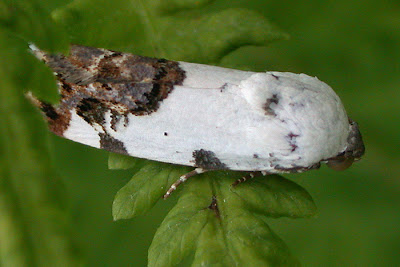I think locally it all really started with a dodgy light fitting at Belleplain, which meant that a certain brick hut was being illuminated all night and has now become a feature at the start of my Belleplain Wildlife walks on Sunday mornings. The sheer variety of moths is stunning in itself, but there's all the complex life style types too. For example, on one recent walk we found a female Pink-striped Oakworm sitting under the eaves of the building. Now this is one of the species that attracts a male not by sight or sound, but by smell! And it was clear that the pheromone that she was invisibly emitting was working as no less than three would-be suitors were buzzing around trying to track her down.
If you haven't got 'moth mania' yet, think about adding this new dimension to your wildlife experiences. You can come and get started on our Belleplain Wildlife walks on Sundays, or just leave an outside light on and see what shows up; you can buy the book, or you can just enjoy them for what they are and not worry about the names. One request though, if you do try mothing with a light, do be aware that moth predators such as lizards, birds and even mice, soon learn about regular food supplies. So try not to run a light at the same place every night and, if possible, use a time switch or get up early so that you can turn the light off before it gets light; that way, the moths can sneak away to a daytime hiding place rather than all end up as somebody's breakfast...
Here's a few Cape May moths that I photographed during the past year, just to scratch the surface of moth diversity:
Moths can be tiny - this Suzuki's Promalactis is just 6mm long...
...or they can be monstrous - the Polyphemus Moth has a wingspan up to 150mm, that's six inches in old money!
Moths can be your basic, typical moth, or they can mimic something else - or even get the imagination going! How about this Imperial Moth for looking like an old banana skin...
...the Juniper-twig Geometer looks like a dead leaf...
...the Common Bird-dropping Moth looks like, well, a bird dropping...
...the Grapeleaf Skeletonizer flies during the day and looks pretty similar to some of our wasps...
...and the very woolly Black-waved Flannel? It looks pretty much like a sheep in need of a shave to me! (See, I told you you could use your imagination too!)
Moths can be day-flying, such as this Celery Looper Moth feeding at Wild Radish flowers at The Beanery...
...they can be wildly exuberant like this stunning Io Moth...
...or wildly improbable like the glorious pink-and-yellow Rosy Maple Moth that got many a camera clicking during our Spring Weekend events recently.
And finally, for those who anguished over the repeated near-misses of the Pink-striped Oakworm males recently - just thought you'd like to know that one of them made it!
Don't let summer 'down-time' from birds keep you indoors - there's a whole world to be explored right here in Cape May - come and join us!
Oh, just one more - how about this Snowberry Clearwing for letting your imagination run riot? I swear it looks like it's riding the sand dunes at Higbee Beach on a jet ski!!!











